A Vulnerability Assessment in Scant Data Context: The Case of North Horr Sub-County
Abstract
1. Introduction
2. Materials
2.1. Study Area: Geographic Positioning and Climatic Context
2.2. Climatic Data
2.3. Demographic Data
2.4. Water Sources
2.5. Hydraulic Conductivity
- Vertical HC or texture: Texture class (USDA system [56]) at 7 standard depths predicted using the global compilation of soil ground observations (available at www.isric.org/explore/isric-soil-data-hub).
- Lateral HC or drainage: Drainage classes are defined according to the Guidelines for Soil Description [56] predicted using the Africa Soil Profiles Database: Very poor, Poor, Imperfect, Moderate, Well, Somewhat Excessive, Excessive (available at www.isric.org/explore/isric-soil-data-hub).
2.6. Civil and Hydraulic Structures
3. Methods
3.1. Exposure
3.1.1. Physical Exposure: Standardized Precipitation Index (SPI) for Drought and Flood Assessment
3.1.2. Demographic Exposure
3.2. Sensitivity
3.2.1. Presence of the Stream
3.2.2. Hydraulic Conductivity
3.3. Adaptive Capacity
3.4. Vulnerability
4. Results
4.1. Exposure
4.1.1. Demographic Exposure
4.1.2. Weighted SPI Index
4.2. Sensitivity
4.2.1. Presence of the Stream
4.2.2. Hydraulic Conductivity
4.3. Adaptive Capacity
4.4. Vulnerability
5. Discussion
6. Conclusions
Author Contributions
Funding
Acknowledgments
Conflicts of Interest
References
- Marshall, S. The water crisis in Kenya: Causes, effects and solutions. Glob. Major. E J. 2011, 2, 31–45. [Google Scholar]
- Mulei Kithiia, S. Water quality degradation trends in kenya over the last decade. In Water Quality Monitoring and Assessment; Voudouris, K., Voutsa, D., Eds.; InTech: Rijeka, Croatia, 2012; pp. 509–526. ISBN 9789535104865. [Google Scholar]
- Moraa, H.; Otieno, A.; Salim, A. Water Governance in Kenya: Ensuring Accessibility, Service Delivery and Citizen Participation; iHubResearch: Nairobi, Kenya, 2012. [Google Scholar]
- UNEP. A Snapshot of the World’s Water Quality: Towards a Global Assessment; United Nations Environment Programme: Nairobi, Kenya, 2016; ISBN 9789280735550. [Google Scholar]
- Borel-Saladin, J. Data dilemmas: Availability, access and applicability for analysis in sub-saharan african cities. Urban Forum 2017, 28, 333–343. [Google Scholar] [CrossRef]
- Osuteye, E.; Johnson, C.; Brown, D. The data gap: An analysis of data availability on disaster losses in sub-Saharan African cities. Int. J. Disaster Risk Reduct. 2017, 26, 24–33. [Google Scholar] [CrossRef]
- Carter, T.R.; Jones, R.; Lu, X.; Bhadwal, S.; Conde, C.; Mearns, L.; Rounsevell, M.; Zurek, M.; Parry, M.; Canziani, O.; et al. New assessment methods and the characterisation of future conditions. Climate Change 2007: Impacts, Adaptation and Vulnerability. In Contribution of Working Group II to the Fourth Assessment Report of the Intergovernmental Panel on Climate Change; Parry, M.L., Canziani, O.F., Palutikof, J.P., van der Linden, P.J., Hanson, C.E., Eds.; Cambridge University Press: Cambridge, UK, 2007; pp. 133–171. [Google Scholar]
- Grasso, V.F.; Dilley, M. A Comparative Review Of Country-Level and Regional Disaster Loss and Damage Databases; United Nations Development Programme: New York, NY, USA, 2013. [Google Scholar]
- Grady, S.C.; Messina, J.P.; McCord, P.F. Population vulnerability and disability in Kenya’s tsetse fly habitats. PLoS Negl. Trop. Dis. 2011, 5. [Google Scholar] [CrossRef] [PubMed]
- Mulefu, F.O.; Mutua, F.N.; Boitt, M. Malaria risk and vulnerability assessment GIS approach. Case study of busia county, Kenya. IOSR J. Environ. Sci. 2016, 10, 104–112. [Google Scholar]
- Githeko, A.K.; Lindsay, S.W.; Confalonieri, U.E.; Patz, J.A. Climate change and vector-borne diseases: A regional analysis. Bull. World Health Organ. 2000, 78, 1136–1147. [Google Scholar]
- Onyango, E.A.; Sahin, O.; Awiti, A.; Chu, C.; Mackey, B. An integrated risk and vulnerability assessment framework for climate change and malaria transmission in East Africa. Malar. J. 2016, 15, 1–12. [Google Scholar] [CrossRef] [PubMed]
- Stoltzfus, J.D.; Carter, J.Y.; Akpinar-Elci, M.; Matu, M.; Kimotho, V.; Giganti, M.J.; Langat, D.; Elci, O.C. Interaction between climatic, environmental, and demographic factors on cholera outbreaks in Kenya. Infect. Dis. Poverty 2014, 3, 37. [Google Scholar] [CrossRef]
- Olago, D.; Marshall, M.; Wandiga, S.O.; Opondo, M.; Yanda, P.Z.; Kangalawe, R.; Githeko, A.; Downs, T.; Opere, A.; Kabumbuli, R.; et al. Climatic, socio-economic, and health factors affecting human vulnerability to cholera in the Lake Victoria Basin, East Africa. Ambio 2007, 36, 350–358. [Google Scholar] [CrossRef]
- Fewtrell, L. Drinking-water nitrate, methemoglobinemia, and global burden of disease: A discussion. Environ. Health Perspect. 2004, 112, 1371–1374. [Google Scholar] [CrossRef]
- Malberg, J.W.; Savage, E.P.; Osteryoung, J. Nitrates in drinking water and the early onset of hypertension. Environ. Pollut. 1978, 15, 155–160. [Google Scholar] [CrossRef]
- Fan, A.M.; Steinberg, V.E. Health implications of nitrate and nitrite in drinking water: An update on methemoglobinemia occurrence and reproductive and developmental toxicity. Regul. Toxicol. Pharmacol. 1996, 23, 35–43. [Google Scholar] [CrossRef] [PubMed]
- Ward, M.H.; Jones, R.R.; Brender, J.D.; de Kok, T.M.; Weyer, P.J.; Nolan, B.T.; Villanueva, C.M.; van Breda, S.G. Drinking water nitrate and human health: An updated review. Int. J. Environ. Res. Public Health 2018, 15, 1557. [Google Scholar] [CrossRef]
- Johnson, C.J.; Kross, B.C. Continuing importance of nitrate contamination of groundwater and wells in rural areas. Am. J. Ind. Med. 1990, 18, 449–456. [Google Scholar] [CrossRef]
- MG, B. Environmental factors associated with nitrate poisoning in livestock in Botswana. J. Pet. Environ. Biotechnol. 2012, 3, 131. [Google Scholar] [CrossRef]
- Ozmen, O.; Mor, F.; Sahinduran, S.; Unsal, A. Pathological and toxicological investigations of chronic nitrate poisoning in cattle. Toxicol. Environ. Chem. 2005, 87, 99–106. [Google Scholar] [CrossRef]
- Campbell, J.B.; Davis, A.N.; Myhr, P.J. Methaemoglonaemia of livestock caused by high nitrate contents of well water. Can. J. Comp. Med. Vet. Sci. 1954, 18, 93–101. [Google Scholar] [PubMed]
- WHO. Nitrate and Nitrite in Drinking-Water: Background Document for Development of WHO Guidelines for Drinking Water Quality. Available online: http://www.who.int/water_sanitation_health/dwq/chemicals/nitratenitrite2ndadd.pdfS (accessed on 18 June 2020).
- Nissen-Petersen, E. Water from Dry Riverbeds; Danish International Development Agency in Kenya: Nairobi, Kenya, 2006. [Google Scholar]
- Collins, R.; Mcleod, M.; Hedley, M.; Donnison, A.; Close, M.; Hanly, J.; Horne, D.; Ross, C.; Davies-Colley, R.; Bagshaw, C.; et al. Best management practices to mitigate faecal contamination by livestock of New Zealand waters. N. Z. J. Agric. Res. 2007, 50, 267–278. [Google Scholar] [CrossRef]
- Burns, D.A.; Nguyen, L. Nitrate movement and removal along a shallow groundwater flow path in a riparian wetland within a sheep-grazed pastoral catchment: Results of a tracer study. N. Z. J. Mar. Freshw. Res. 2010, 371–385. [Google Scholar] [CrossRef]
- Davies-Colley, R.J.; Nagels, J.W.; Smith, R.A.; Young, R.G.; Phillips, C.J. Water quality impact of a dairy cow herd crossing a stream. N. Z. J. Mar. Freshw. Res. 2004, 38, 569–576. [Google Scholar] [CrossRef]
- Collins, R.; Rutherford, K. Modelling bacterial water quality in streams draining pastoral land. Water Res. 2004, 38, 700–712. [Google Scholar] [CrossRef] [PubMed]
- Nagels, J.W.; Davies-Colley, R.J.; Donnison, A.M.; Muirhead, R.W. Faecal contamination over flood events in a pastoral agricultural stream in New Zealand. Water Sci. Technol. 2002, 45, 45–52. [Google Scholar] [CrossRef] [PubMed]
- Hoppe, B.O.; Raab, K.K.; Blumenfeld, K.A.; Lundy, J. Vulnerability assessment of future flood impacts for populations on private wells: Utilizing climate projection data for public health adaptation planning. Clim. Change 2018, 148, 533–546. [Google Scholar] [CrossRef]
- Djoudi, S.; Boulabiez, F.; Pistre, S.; Houha, B. Assessing groundwater vulnerability to contamination in a semi-arid environment using DRASTIC and GOD models, Case of F’kirina Plain, North of Algeria. IOSR J. Environ. Sci. 2019, 13, 39–44. [Google Scholar]
- Boulabeiz, M.; Klebingat, S.; Agaguenia, S. A GIS-Based GOD model and hazard index analysis: The quaternary coastal collo aquifer (NE-Algeria). Groundwater 2019, 57, 166–176. [Google Scholar] [CrossRef] [PubMed]
- Ghazavi, R.; Ebrahimi, Z. Assessing groundwater vulnerability to contamination in an arid environment using DRASTIC and GOD models. Int. J. Environ. Sci. Technol. 2015, 12, 2909–2918. [Google Scholar] [CrossRef]
- Bataineh, S.; Curtis, C.; In, M.’; Alghwazi, Z. Groundwater Resources, the DRASTIC Method and Applications in Jordan. Available online: http://courses.washington.edu/cejordan/SbCcMa_Presentation.pdf (accessed on 7 February 2020).
- Zhou, Z.; Ansems, N.; Torfs, P. A Global Assessment of Nitrate Contamination in Groundwater Internship Report; International Groundwater Resources Assessment Center: Delft, The Netherlands, 2015. [Google Scholar]
- Martínez-Salvador, C.; Moreno-Gómez, M.; Liedl, R. Estimating pollutant residence time and NO3 concentrations in the Yucatan karst aquifer; considerations for an integrated karst aquifer vulnerability methodology. Water 2019, 11, 1431. [Google Scholar] [CrossRef]
- Panagopoulos, Y.; Makropoulos, C.; Baltas, E.; Mimikou, M. SWAT parameterization for the identification of critical diffuse pollution source areas under data limitations. Ecol. Modell. 2011, 222, 3500–3512. [Google Scholar] [CrossRef]
- Birkmann, J. Measuring Vulnerability to promote disaster-resilient societies: Conceptual framewors and definitions. In Measuring Vulnerability to Natural Hazards: Towards Disaster Resilient Societies; United Nation University Press: Tokyo, Japan, 2006; pp. 9–54. [Google Scholar]
- Science in support of adaptation to climate change. In Proceedings of the Conference of the Parties to the United Nations Framework Convention on Climate Change, Buenos Aires, Argentina, 7 December 2004.
- Field, C.B.; Barros, V.R.; Dokken, D.J.; Mach, K.J.; Mastrandrea, M.D.; Bilir, T.E.; Chatterjee, M.; Yuka, K.L.E.; Estrada, O.; Genova, R.C.; et al. Climate Change 2014 Impacts, Adaptation, and Vulnerability Part A: Global and Sectoral Aspects Working Group II Contribution to the Fifth Assessment Report of the Intergovernmental Panel on Climate Change; Cambridge University Press: New York, NY, USA, 2014; ISBN 978-1-107-05807-1. [Google Scholar]
- Cardona, O.-D.; van Aalst, M.K.; Birkmann, J.; Fordham, M.; McGregor, G.; Perez, R.; Pulwarty, R.S.; Lisa Schipper, E.F.; Tan Sinh, B.; Décamps, H.; et al. Determinants of risk: Exposure and vulnerability. In Managing the Risks of Extreme Events and Disasters to Advance Climate Change Adaptation; Cambridge University Press: Cambridge, UK; New York, NY, USA, 2012. [Google Scholar]
- Belcore, E.; Pezzoli, A.; Calvo, A. Analysis of gender vulnerability to climate-related hazards in a rural area of Ethiopia. Geogr. J. 2019, 1–15. [Google Scholar] [CrossRef]
- Nolan, B.T.; Hitt, K.J. Vulnerability of shallow groundwater and drinking-water wells to nitrate in the United States. Environ. Sci. Technol. 2006, 40, 7834–7840. [Google Scholar] [CrossRef]
- Tesoriero, A.J.; Puckett, L.J. O2 reduction and denitrification rates in shallow aquifers. Water Resour. Res. 2011, 47. [Google Scholar] [CrossRef]
- Orindi, V.A.; Ochieng, A. Case study 5: Kenya seed fairs as a drought recovery strategy in Kenya. IDS Bull. 2005, 36, 87–102. [Google Scholar] [CrossRef][Green Version]
- Karanja, F.; Mutua Nairobi, F. Reducing the Impact of Environmental Emergencies through Early Warning and Preparedness-the Case of el Niño-Southern Oscillation (ENSO); UNFIP/UNEP/NCAR/WMO/DNDR/UNU: Nairobi, Kenya, 2000; Available online: https://profiles.uonbi.ac.ke/coludhe/publications/reducing-impacts-environmental-emergencies-through-early-warning-and-preparedne (accessed on 26 March 2020).
- Ogalo, L.; Owiti, Z.; Mutemi, J. Linkages between the Indian Ocean Dipole and East African Rainfall Anomalies. J. Kenya Meteorol. Soc. 2008, 2, 3–17. [Google Scholar]
- Kuria, Z. Groundwater distribution and aquifer characteristics in Kenya. In Developments in Earth Surface Processes; Elsevier: Amsterdam, The Netherlands, 2013; Volume 16, pp. 83–107. [Google Scholar]
- Vigna, I.; Bigi, V.; Pezzoli, A.; Besana, A. Comparison and bias-correction of satellite-derived precipitation datasets at local level in Northern Kenya. Sustainability 2020, 12, 2896. [Google Scholar] [CrossRef]
- Kenya National Bureau of Statistics 2019 Kenya Population and Housing Census Volume 1: Population by County and Sub-County; KNBS: Nairobi, Kenya, 2019; Volume I, ISBN 9789966102096.
- Rutten, M. Shallow Wells: A Sustainable and Inexpensive Alternative to Boreholes in Kenya. In Proceedings of the EU Conference Support to Marginal Rural Areas in Somalia, Nairobi, Kenya, 23–26 November 2004. [Google Scholar]
- Water Supply and Sanitation in Kenya Turning Finance into Services for 2015 and Beyond An AMCOW Country Status Overview; Water and Sanitation Program: Nairobi, Kenya, 2011.
- County Government of Marsabit Second County Integrated Development Plan 2018–2022. Available online: http://marsabit.go.ke/wp-content/uploads/2019/10/Marsabit-CIDP-2018-2022.pdf (accessed on 26 March 2020).
- Mumma, A.; Lane, M.; Kairu, E.; Tuinhof, A.; Hirji, R. Kenya Groundwater Governance Case Study; Water Papers; Worldbank: Washington, DC, USA, 2011; Available online: http://water.worldbank.org/water/sites/worldbank.org.water/files/GWGovernanceKenya.pdf (accessed on 26 March 2020).
- Di Molfetta, A.; Sethi, R. Ingegneria Degli Acquiferi; Springer Science & Business Media: Milano, Italy, 2012; ISBN 9788847018501. [Google Scholar]
- IUSS Working Group WRB. World Reference Base for Soil Resources 2014: International Soil Classification System for Naming Soils and Creating Legends for Soil Maps; Food and Agriculture Organization of the United Nations: Rome, Italy, 2014; ISBN 9789251083697. [Google Scholar]
- Mckee, T.B.; Doesken, N.J.; Kleist, J. The relationshio of drought frequency and duration to time scales. In Proceedings of the Eighth Conference on Applied Climatology, Anaheim, CA, USA, 17 January 1993. [Google Scholar]
- World Meteorological Organization (WMO). Standardized Precipitation Index User Guide (WMO-No. 1090); World Meteorological Organization: Geneva, Switzerland, 2012. [Google Scholar]
- Liu, X.; Wang, Y.; Peng, J.; Braimoh, A.K.; Yin, H. Assessing vulnerability to drought based on exposure, sensitivity and adaptive capacity: A case study in middle Inner Mongolia of China. Chinese Geogr. Sci. 2013, 23, 13–25. [Google Scholar] [CrossRef]
- Tahmasebi, A. Pastoral Vulnerability to Socio-Political and Climate Stresses: The Shahsevan of North Iran; LIT Verlag: Münster, Germany, 2013. [Google Scholar]
- Liu, D.; You, J.; Xie, Q.; Huang, Y.; Tong, H.; Xie, J.F.; Huang, Q.J.; Tong, Y.Y.; Liu, D. Spatial and temporal characteris-tics of drought and flood in Quanzhou based on Standardized Precipitation Index (SPI) in recent 55 years. J. Geosci. Environ. Prot. 1960, 6, 25–37. [Google Scholar]
- Seiler, R.A.; Hayes, M.; Bressan, L. Using the standardized precipitation index for flood risk monitoring. Int. J. Climatol. 2002, 22, 1365–1376. [Google Scholar] [CrossRef]
- Shahid, S.; Behrawan, H. Drought risk assessment in the western part of Bangladesh. Nat. Hazards 2008, 46, 391–413. [Google Scholar] [CrossRef]
- Copernicus European Drought Observatory. Standardized Precipitation Index (SPI). Available online: https://edo.jrc.ec.europa.eu/edov2/php/index.php?id=1101 (accessed on 24 February 2020).
- Huizinga, J.; De Moel, H.; Szewczyk, W. JRC Technical Reports Global Flood Depth-Damage Functions; Publications Office of the European Union: Brussels, Belgium, 2017. [Google Scholar]
- Fan, Y.; Miguez-Macho, G. A simple hydrologic framework for simulating wetlands in climate and earth system models. Clim. Dyn. 2011, 37, 253–278. [Google Scholar] [CrossRef]
- Ju, W.; Chen, J.M.; Black, T.A.; Barr, A.G.; McCaughey, H.; Roulet, N.T. Hydrological effects on carbon cycles of Canada’s forests and wetlands. Tellus B 2006, 58. [Google Scholar] [CrossRef]
- Elema, S.U. Effects of Climate Variability on Water and Pasture Availability in Turbi Division of Marsabit County, Kenya, 2018; Kenyatta University: Nairobi, Kenya, 2018. [Google Scholar]
- Hazard, B.; Adongo, C.; Wario, A.; Ledant, M. Comprehensive Study of Pastoral Livelihoods, WASH and Natural Resource Managment in Northern Marsabit; IFRA: Nairobi, Kenya, 2012. [Google Scholar]
- WHO. Guidelines for Drinking-Water Quality: Fourth Edition Incorporating the First Addendum; World Health Organization: Geneva, Switzerland, 2014; ISBN 9789241549950. [Google Scholar]
- Vicente-Serrano, S.M.; Beguería, S.; Lorenzo-Lacruz, J.; Camarero, J.J.; López-Moreno, J.I.; Azorin-Molina, C.; Revuelto, J.; Morán-Tejeda, E.; Sanchez-Lorenzo, A. Performance of drought indices for ecological, agricultural, and hydrological applications. Earth Interact. 2012, 16, 1–27. [Google Scholar] [CrossRef]
- Niang, I.; Ruppel, O.C.; Abdrabo, M.A.; Dube, P.; Leary, N.; Schulte-Uebbing, L.; Field, C.; Dokken, D.; Mach, K.; Bilir, T.; et al. Climate Change 2014: Impacts, Adaptation, and Vulnerability. Part B: Regional Aspects. Contribution of Working Group II to the Fifth Assessment Report of the Intergovernmental Panel on Climate Change; Barros, V.R., Field, C.B., Dokken, D.J., Mastrandrea, M.D., Mach, K.J., Bilir, T.E., Chatterjee, M., Ebi, K.L., Estrada, Y.O., Genova, R.C., et al., Eds.; Cambridge University Press: Cambridge, UK; New York, NY, USA, 2014; pp. 1199–1265. [Google Scholar]
- Rendilicha, H.G. A review of groundwater vulnerability assessment in Kenya. Acque Sotter. Ital. J. Groundw. 2018, 7. [Google Scholar] [CrossRef]
- REACH. Country Diagnostic Report, Kenya. REACH Working Paper 3; University of Oxford: Oxford, UK, 2015; ISBN 9781874370611. [Google Scholar]
- Nyilitya, B.; Mureithi, S.; Boeck, P. Tracking sources and fate of groundwater nitrate in Kisumu City and Kano Plains, Kenya. Water 2020, 12, 401. [Google Scholar] [CrossRef]
- Yong Lee, B.W.; Member, S.; Dahab, M.F.; Bogardi, I. Nitrate risk management under uncertainty. J. Water Resour. Plann. Manag. 1992, 118, 151–165. [Google Scholar]
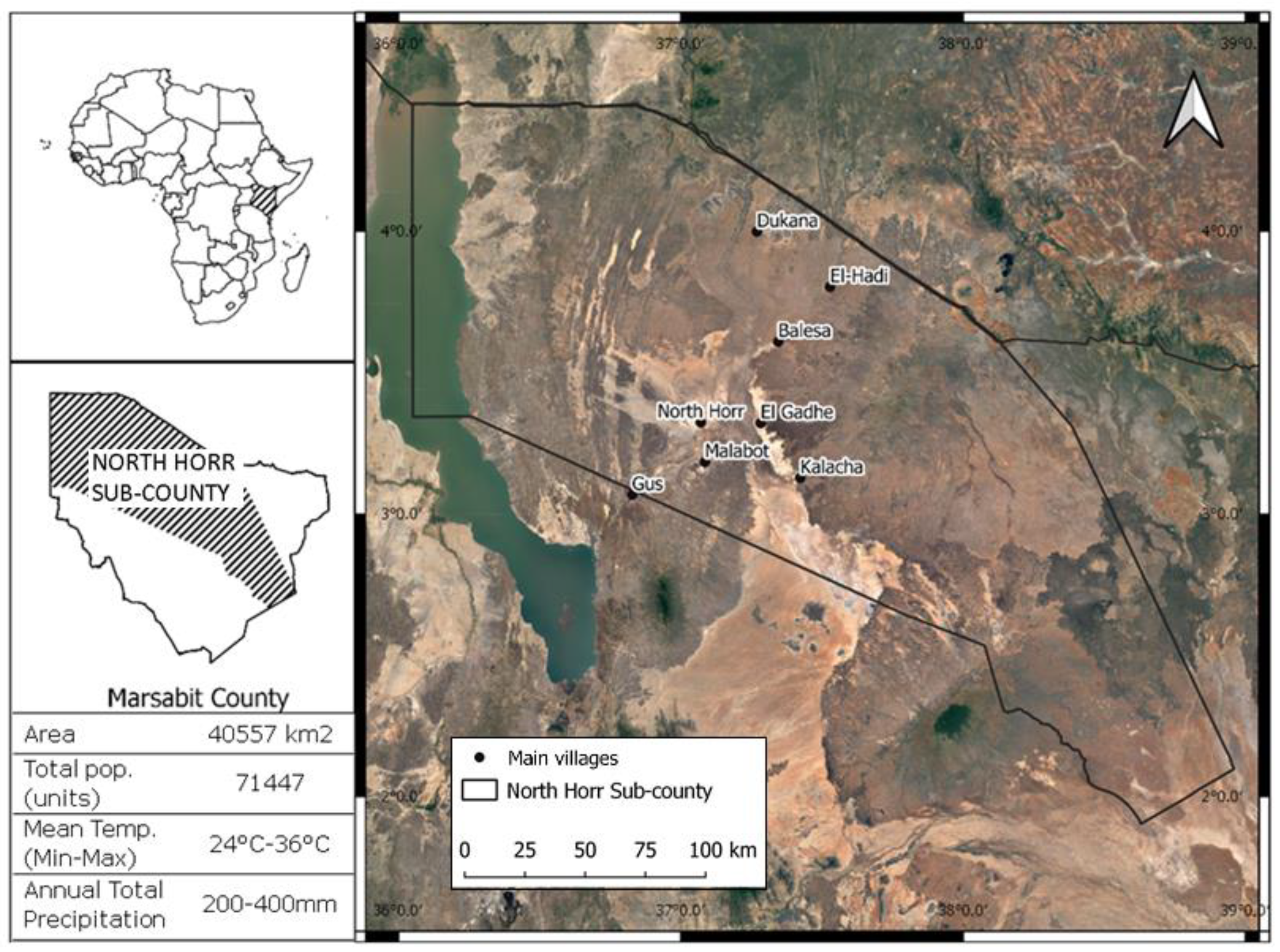
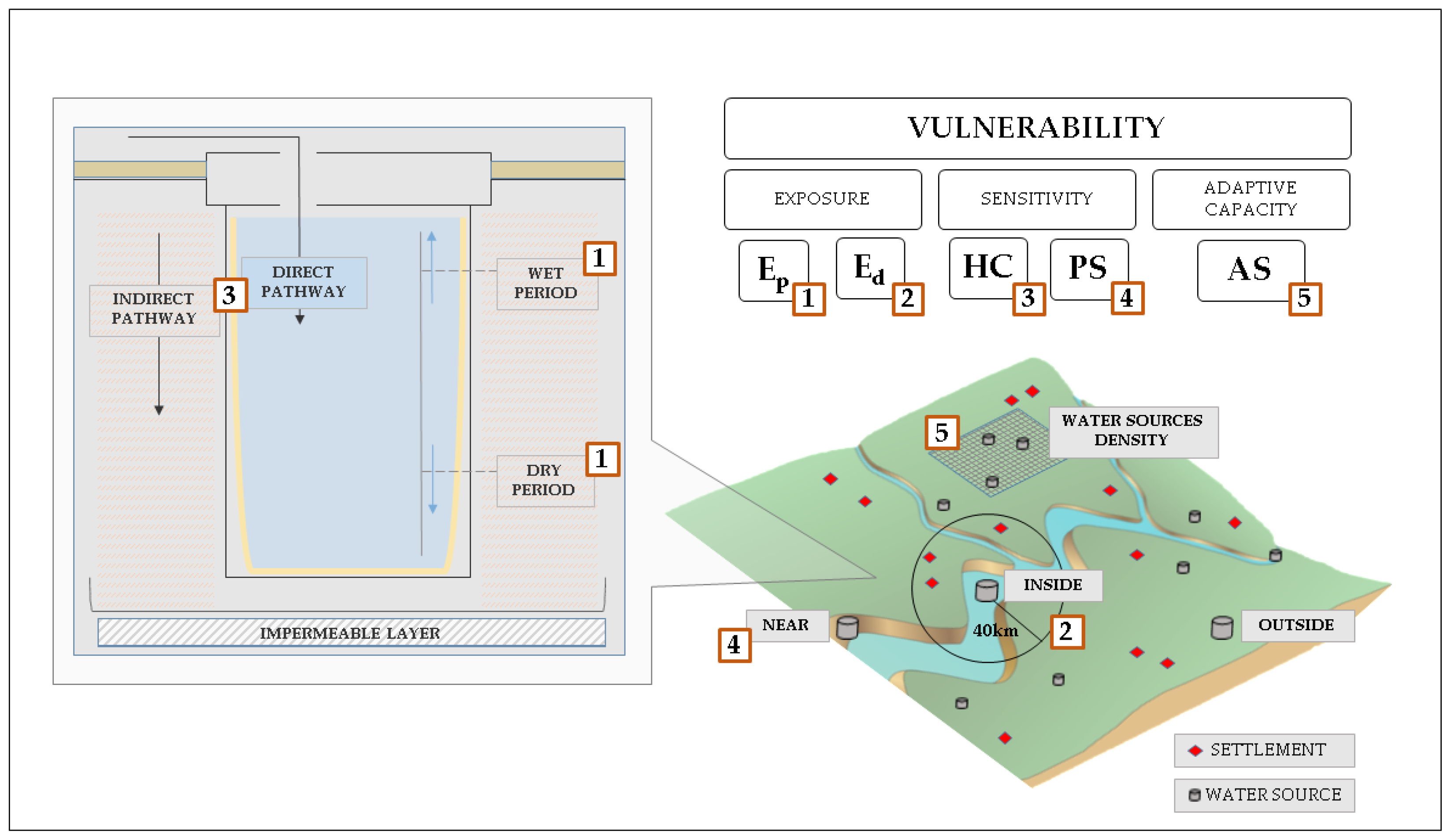



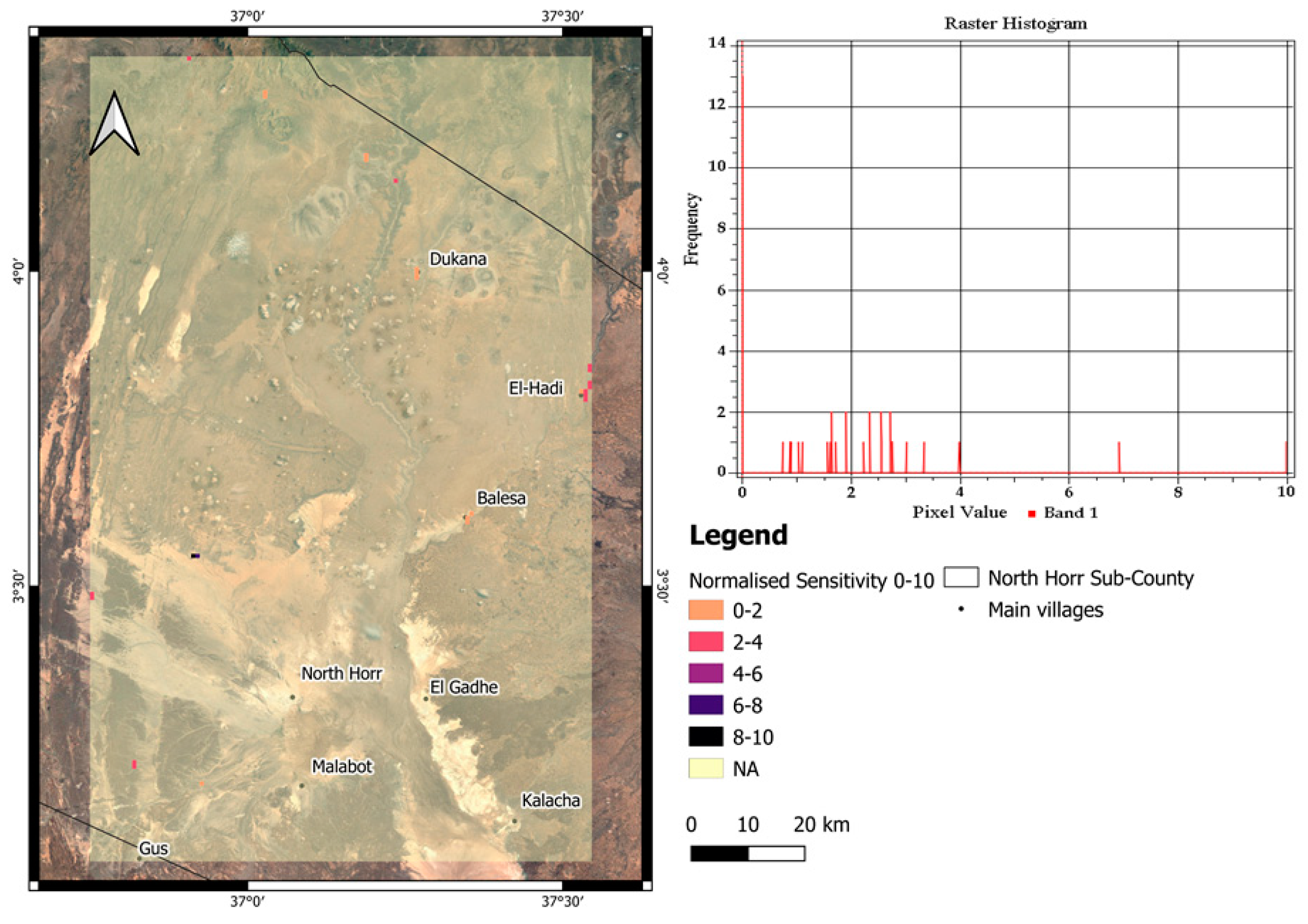
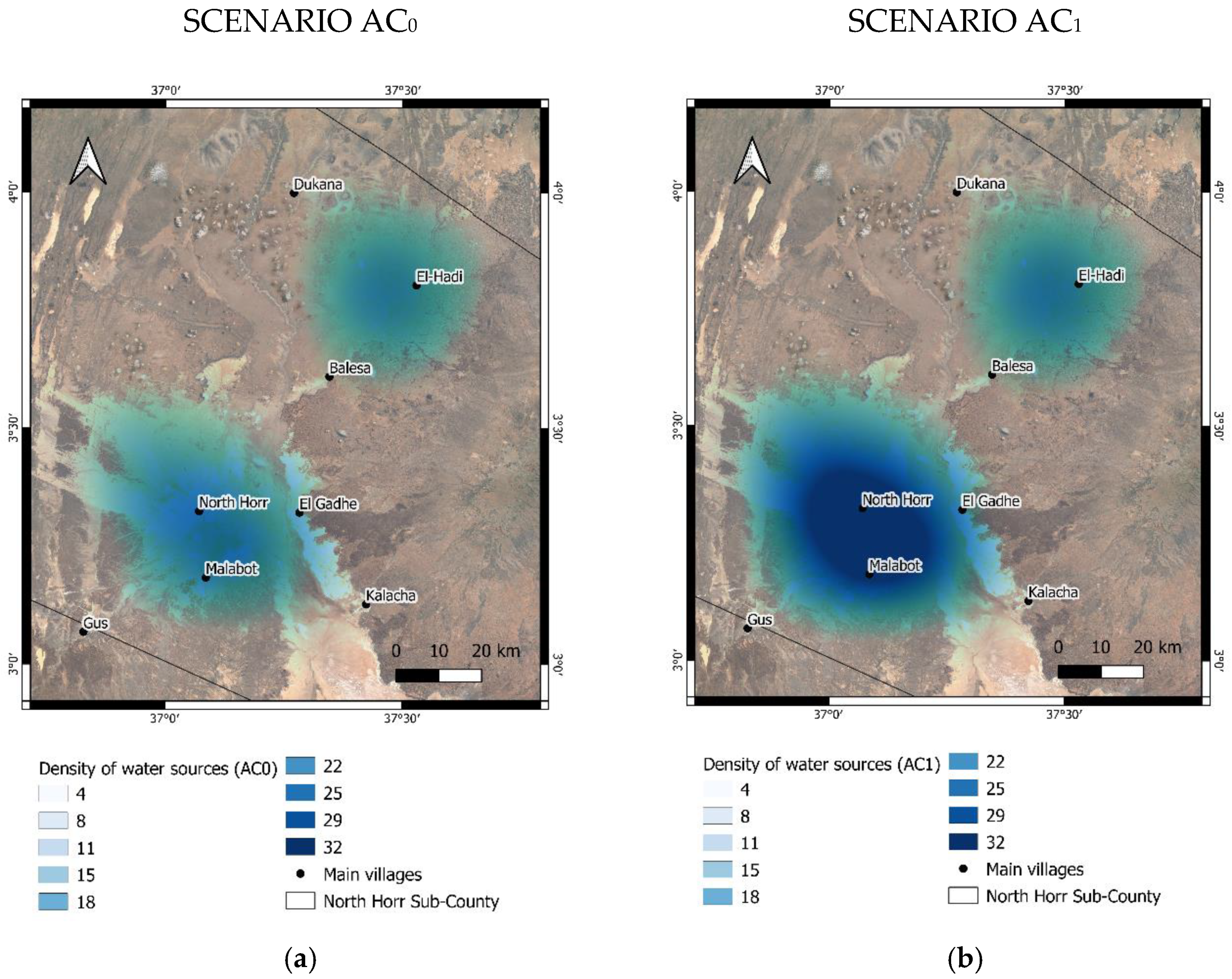
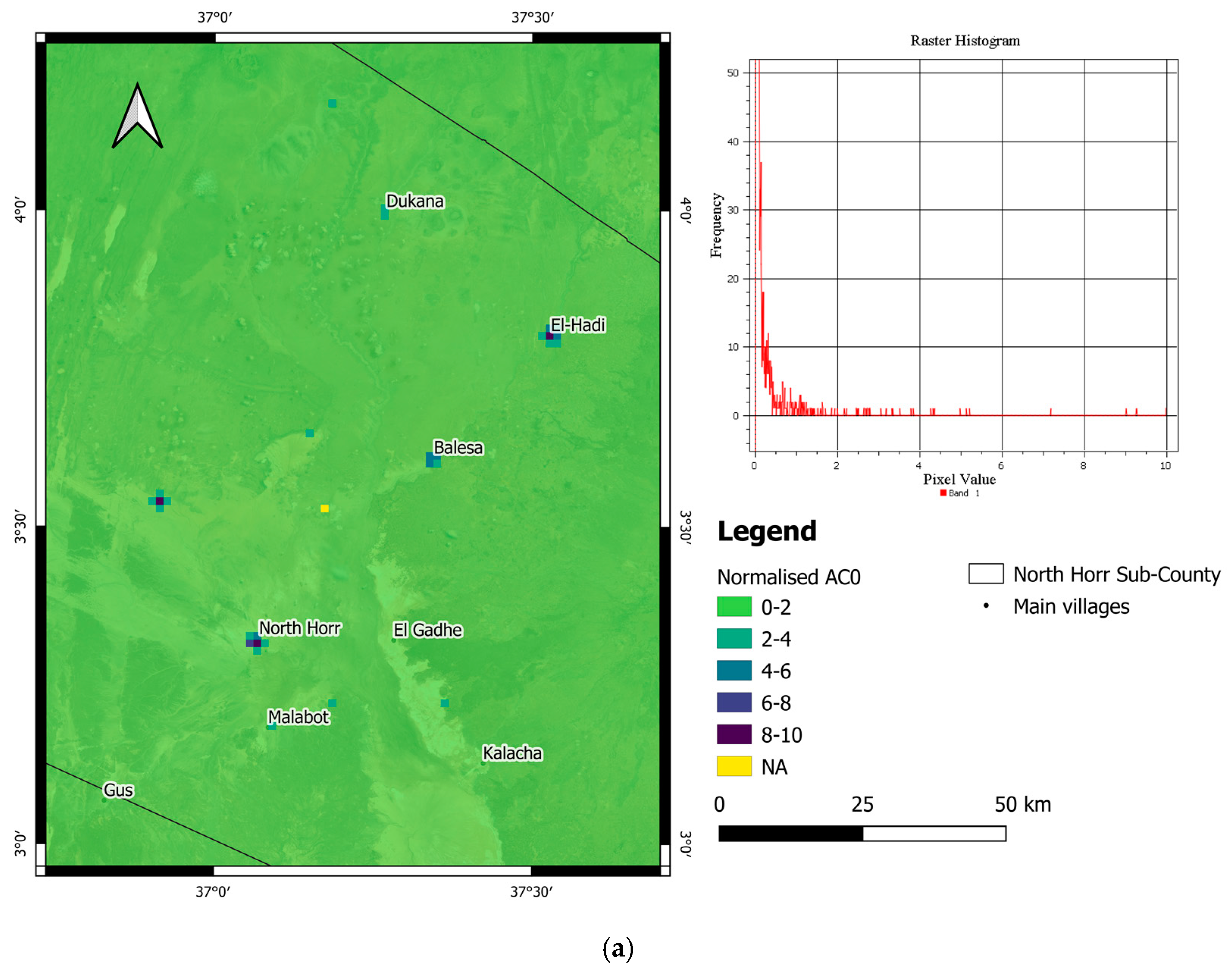

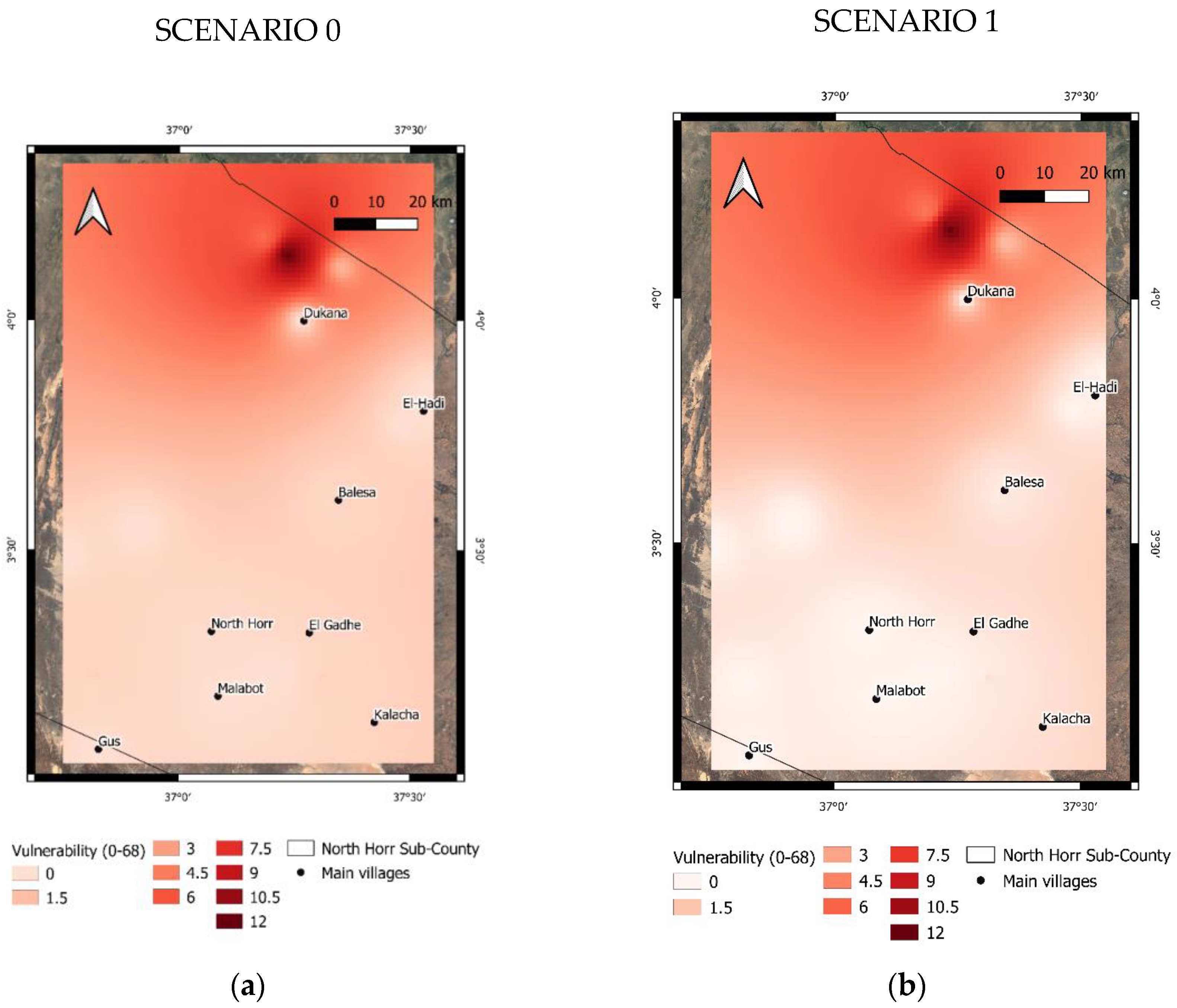
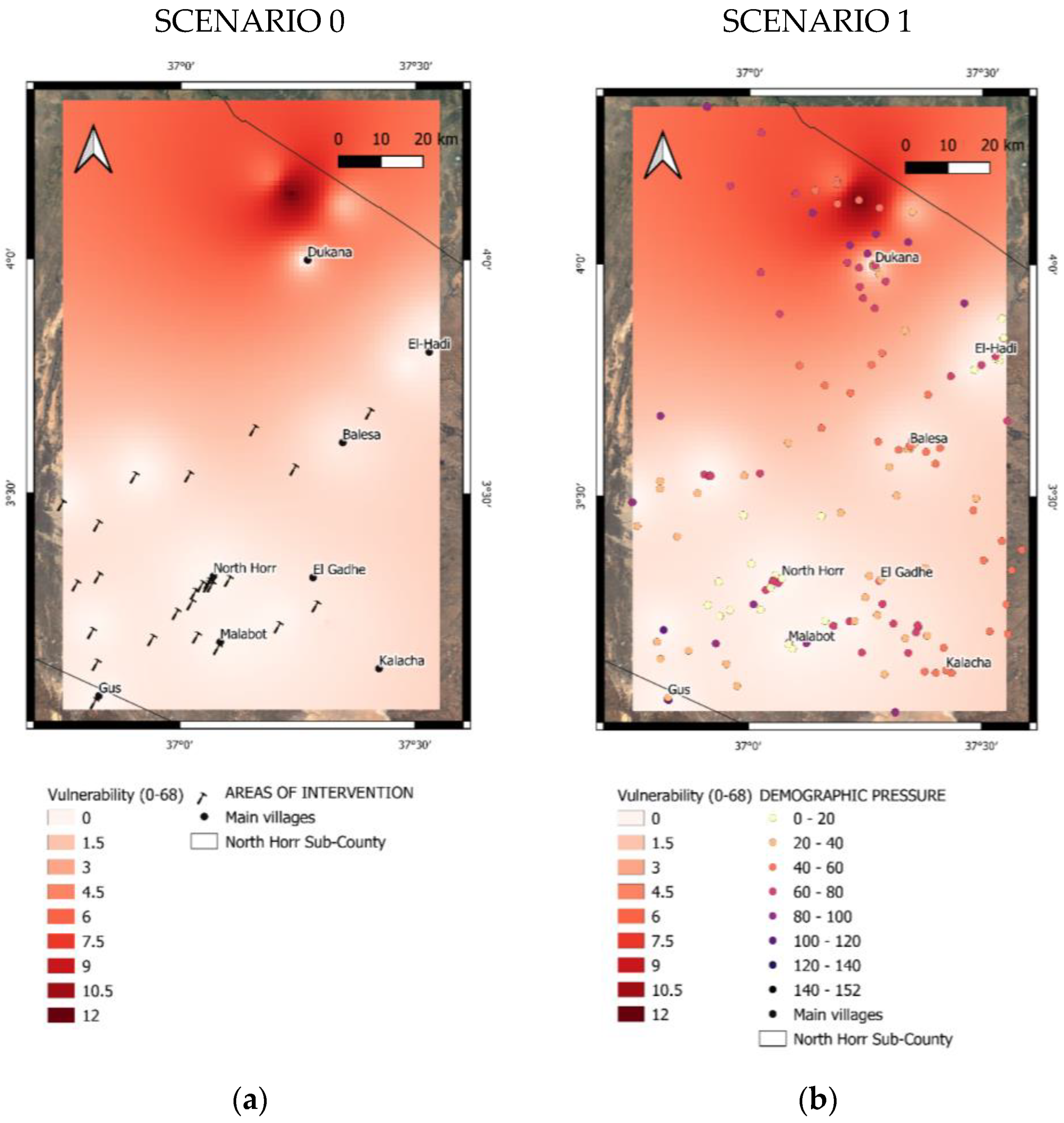
| Shallow Wells | Earth Pans/Dams | Rock Catchments | Total Water Points | |
|---|---|---|---|---|
| One Health platform | 11 | 3 | 0 | 14 |
| Concern Worldwide | 43 | 3 | 2 | 48 |
| 54 | 6 | 2 | 62 |
| Indicator | Sub-Indicators | Data Source | Original Type of Source | Original Dimension/Resolution | Projection | |
|---|---|---|---|---|---|---|
| Exposure (E) | Physical drought and flood exposure (Ep) | Weighted SPI indices | BCKMD [49] | Point vector | Village level | WGS 84/UTM zone 37N |
| Demographic Exposure (Ed) | Weighted maximum number of settlements potentially using the water source | Kenya Population Census 2019 (KNBS) | Point vector | Water-source level | WGS 84/UTM zone 37N | |
| Sensitivity (S) | Hydraulic conductivity (HC) | Drainage and texture | ISRIC http://www.isric.org/explore/isric-soil-data-hub | Raster | 0.002° × 0.002° | WGS 84 |
| Presence of the stream (PS) | Water source distance from the stream | Point vector | Water-source level | WGS 84/UTM zone 37N | ||
| Adaptive Capacity (AC) | Adaptive strategies (AS) | Density of water sources | Second County Integrated Development Plan 2018–2022 | Point vector | Water-source level | WGS 84/UTM zone 37N |
| Presence of the Stream | Weight |
|---|---|
| Inside | 1 |
| Near | 0.6 |
| Outside | 0.2 |
| Soil Texture | |
|---|---|
| Soil Texture Class | Vertical HC (m/Day) |
| Sand | 15.206 |
| Loamy Sand | 13.504 |
| Sandy Loam | 2.998 |
| Silt Loam | 0.622 |
| Loam | 0.605 |
| Sandy Clay Loam | 0.544 |
| Silty Clay Loam | 0.121 |
| Clay Loam | 0.216 |
| Sandy Clay | 0.190 |
| Silty Clay | 0.086 |
| Clay | 0.112 |
| Peat | 0.691 |
| Soil Drainage | |
|---|---|
| Drainage Class | Lateral HC (m/Day) |
| Very poor | 10 |
| Poor | 15 |
| Imperfect | 20 |
| Moderately well | 25 |
| Well | 30 |
| Rapid | 40 |
| Excessive | 50 |
| Place Name | Gensets and Solar Panel | Construction of Shallow Wells | Piped Water | Drilling of Borehole | Water Towers | Dam | Underground Tanks | Water Trough |
|---|---|---|---|---|---|---|---|---|
| Durte | ● | ● | ||||||
| Barambate | ● | |||||||
| Khob dertu | ● | |||||||
| Elbeso | ● | ● | ● | ● | ||||
| Konon Gos | ● | |||||||
| Qorqa Gudha | ● | |||||||
| El-Isacko Mala | ● | ● | ||||||
| El-Gufu | ● | |||||||
| Barambate | ||||||||
| El-Buka | ● | |||||||
| Boji | ● | |||||||
| Goricha village | ● | ● | ● | |||||
| Malabot | ● | ● | ● | |||||
| North Horr | ● | ● | ||||||
| Galas | ● | ● | ● | |||||
| El Boru Magado | ● | ● | ||||||
| Eredheri | ● | |||||||
| Lag Balal | ● | |||||||
| Tiniqo | ● | ● | ||||||
| Qorqa Diqa | ● | ● | ||||||
| Hurri Diqa | ● | |||||||
| Elmuda | ● | |||||||
| Wanno | ● | |||||||
| Bara | ● | |||||||
| Ruso | ● | ● | ||||||
| Horri Gudha | ● | ● |
| Physical Exposure (Ep) | |||||
|---|---|---|---|---|---|
| Flood | Drought | ||||
| SPI1 | SPI3 | SPI3 | SPI6 | SPI12 | |
| Facilities | |||||
| Balesa | 18 | 13 | 9 | 21 | 20 |
| Dukana | 16 | 15 | 11 | 15 | 17 |
| El Gadhe | 16 | 13 | 6 | 19 | 21 |
| El Hadi | 18 | 11 | 12 | 19 | 20 |
| Gus | 17 | 19 | 6 | 21 | 15 |
| Kalacha | 21 | 14 | 3 | 5 | 15 |
| Malabot | 17 | 15 | 3 | 13 | 19 |
| North Horr | 22 | 15 | 6 | 15 | 17 |
| Stations | |||||
| Lodwar | 16 | 12 | 6 | 18 | 15 |
| Marsabit | 17 | 15 | 6 | 12 | 18 |
| Moyale | 15 | 17 | 6 | 18 | 15 |
| Boreholes | Earth Pans/Dams | Hand-Dug Wells | Shallow Wells | Piped Water | Rock Catchments | Springs | Others (Underground Tanks, Tanks) | |
|---|---|---|---|---|---|---|---|---|
| AC0 | 10 | 6 | 13 | 54 | 0 | 2 | 11 | 14 |
| AC1 | 16 | 6 | 13 | 59 | 10 | 2 | 11 | 16 |
© 2020 by the authors. Licensee MDPI, Basel, Switzerland. This article is an open access article distributed under the terms and conditions of the Creative Commons Attribution (CC BY) license (http://creativecommons.org/licenses/by/4.0/).
Share and Cite
Bigi, V.; Pezzoli, A.; Comino, E.; Rosso, M. A Vulnerability Assessment in Scant Data Context: The Case of North Horr Sub-County. Sustainability 2020, 12, 6024. https://doi.org/10.3390/su12156024
Bigi V, Pezzoli A, Comino E, Rosso M. A Vulnerability Assessment in Scant Data Context: The Case of North Horr Sub-County. Sustainability. 2020; 12(15):6024. https://doi.org/10.3390/su12156024
Chicago/Turabian StyleBigi, Velia, Alessandro Pezzoli, Elena Comino, and Maurizio Rosso. 2020. "A Vulnerability Assessment in Scant Data Context: The Case of North Horr Sub-County" Sustainability 12, no. 15: 6024. https://doi.org/10.3390/su12156024
APA StyleBigi, V., Pezzoli, A., Comino, E., & Rosso, M. (2020). A Vulnerability Assessment in Scant Data Context: The Case of North Horr Sub-County. Sustainability, 12(15), 6024. https://doi.org/10.3390/su12156024






